- Alle laptops
- Top 10 laptops
- Refurbished laptops
- Zakelijke laptops
- Gaming laptops
- Windows laptops
- Apple MacBooks
- Mini laptops
- Chromebooks
- Surface Pro
- Surface Laptop
- Surface Accessoires
- 11 inch laptops
- 12 inch laptops
- 13 inch laptops
- 14 inch laptops
- 15 inch laptops
- 16 inch laptops
- 17 inch laptops
- Ergonomische muizen
- Laptop tassen
- Laptop sleeves
- Laptop rugzakken
- Externe harde schijven
- Externe DVD spelers
- Rekenmachines
- Laptopstandaarden
- Docking stations
- Laptop sloten
- Adapters & Accu's
- Accu vervangen?
- Microsoft Windows
- Microsoft Office
- Antivirus & Beveiliging
- Norton Security
- Software downloads
- Koopgids laptop
- Laptop of desktop?
- Home & Office desktops
- Paradigit Workstations
- Gaming desktops
- Powered by MSI
- Stel zelf samen
- Alle desktops
- Top 10 desktops
- Refurbished desktops
- Zakelijke desktops
- All-in-one PC's
- Thin Clients
- Server Racks
- Toetsenborden
- Gamecontrollers & Joysticks
- KVM Switches
- Voedingskabels
- Gereedschap
- Barcode scanners
- Koopgids desktop
- NVIDIA Shield TV
- NVIDIA RTX laptops
- NVIDIA GTX laptops
- NVIDIA Videokaarten
- Videokaarten
- Behuizingen
- Moederborden
- SSD Schijven
- Processoren
- Intern geheugen
- Geluidskaarten
- Casemodding
- Gaming toetsenborden
- Gaming muizen
- Gaming headsets

Telefonie & Tablets
- Smartphones
- Top 10 smartphones
- Telefoon + abonnement
- Smartwatches
- Alle tablets
- Top 10 tablets
- Tekentablet
- Tablet hoezen
- Stylus pennen
- Docks & Toetsenborden
- Alle E-readers
- E-reader hoezen
- Bluetooth speakers
- Koptelefoons en oordopjes
- Kabels en adapters
- Koopgids tablet
Netwerk & Smarthome
- Accesspoints
- Powerline homeplugs
- Range extenders
- MiFi routers
- Multiroom WiFi
- Netwerkadapters
- Netwerkkaarten
- Top 10 routers
- Netwerkkabels
- Slimme speakers
- IP camera's
- IP camera accessoires
- Koopgids router
- Koopgids homeplug
- Koopgids switch
- Koopgids NAS
- Koopgids smarthome
Randapparatuur
- Video conferencing
- Large format displays
- Monitorkabels
- Monitor beugels
- KVM switches
- LFD – Ophangsystemen & Standaards
- Ergonomische toetsenborden
- Tekentablets
- Koptelefoons & oordopjes
- Audiokabels
- MiFi Routers
- All-in-one printers
- Zakelijke printers
- Laserprinters
- Labelprinters
- Ink-selector
- Papier & labels
Beeld & Geluid
- Top 10 monitoren
- Gaming monitoren
- Monitor kabels
- Koopgids monitor
- Koopgids beamer
- Koopgids koptelefoon
- Koopgids mediaspeler
- Koopgids speaker
- Alle printers
- Top 10 printers
- Inkt Selector
- Papier & Labels
- Koopgids printer
- Alle SSD's
- 2,5 inch SATA
- Interne SSD
- Externe SSD
- Kingston SSD
- Samsung SSD
- Seagate SSD
- Western Digital SSD
- Interne harde schijven
- Alle harde schijven
- Top 10 harde schijven
- Geheugenkaarten
- DVD/Blu-ray drives
- Harde schijf behuizingen
- Kaartlezers
- Koopgids SSD
- Koopgids interne HDD
- Koopgids externe HDD
- Koopgids USB stick
Componenten
- Werkgeheugen
- SSD schijven
- Controllers
- Processor koelers
- Casemodding & Kabels
- Antivirus en beveiliging
- Workstations
- Koopgids moederbord
- Koopgids processor
- Koopgids videokaart
- Koopgids werkgeheugen
- Koopgids voeding
- Mobiele workstations
- Zakelijke All-in-One PC's
- Home & Office
- Zakelijke kabels
- Antivirus en Beveiliging
- Koopgids laptops
- Koopgids Microsoft Office
- Koopgids antivirus
- Keuzehulp accu's & adapters
- Kies een categorie

- Built by Paradigit
- Koopgidsen & Tips

- Intel® Core™ i9-7980XE processor
- 128 GB werkgeheugen
- 4 TB SSD + 50 TB harde schijf
- 2x NVIDIA® GeForce® Titan Xp - 24 GB
- Windows 10 Pro
- Gratis verzending vanaf €20,-
- 14 dagen bedenktijd
- Gratis afhalen in onze winkels
- Avond- en tijdvaklevering

Specificaties
Alternatieven, winkelvoorraad, droom van iedere gamer, indrukwekkende componenten.
Qua geheugen is er ook flink uitgepakt. Ter vergelijking: een bovengemiddelde gaming pc beschikt over 16 GB werkgeheugen. De Voyager is met 8 keer zoveel geheugen uitgerust, namelijk 128 GB. Over het opslaan van eindeloos veel bestanden is ook nagedacht: de Voyager heeft 4 TB aan SSD opslag. En omdat het downloaden van bestanden veel van de capaciteit van een harde schijf vraagt, kan deze tot wel 50 TB aan data bewaren. Een groot pluspunt, want de meeste gamers bewaren hun spellen in een ‘Steam bibliotheek’. Deze hoeveelheid opslag maakt het echter mogelijk om alle games op de computer zelf te installeren.
Geen multitasking, maar megatasking
Zeer beperkte oplage, windows 10: het beste van oud en nieuw in één.
- De startknop is terug Het ontbreken van de good old startknop was voor veel Windows gebruikers in Windows 8 een groot gemis. Microsoft heeft daarom Windows 10 uitgerust met de vertrouwde startknop.
- Het startmenu heeft een face lift ondergaan De terugkeer van de startknop betekent ook de terugkeer van het startmenu. Dit startmenu heeft wel wat veranderingen ondergaan. U vindt hier naast programma's ook mappen en interactieve widgets. Verder vindt u in het startmenu een zoekbalk waarmee u niet alleen uw device kunt doorzoeken, maar ook het internet.
- U kunt meerdere bureaubladen gebruiken Task View maakt het mogelijk om een visueel overzicht van alle open vensters op te roepen. Verder kunt u meerdere bureaubladen aanmaken, waar u eenvoudig tussen kunt wisselen. Een uiterst handige feature voor de intensieve multitasker.
- Apps en desktopprogramma’s zijn te schalen In Windows 8 kunnen apps uitsluitend schermvullend worden getoond, in tegenstelling tot desktopprogramma’s die u naar eigen inzicht kunt vergroten of verkleinen. Dit werd door veel gebruikers als vervelend ervaren. In Windows 10 is dit probleem verholpen en kunt u apps, net als desktopprogramma's, openen in vensters. Minimaliseren en maximaliseren is dan ook mogelijk.
- Windows 10 is geschikt voor al uw apparaten Windows 10 is geschikt voor uw laptops of desktop, maar ook tablets en smartphones werken uitstekend op Windows 10. Ieder Windows 10-apparaat beschikt daarnaast over dezelfde appstore en dus dezelfde apps.
- Sterkere beveiliging Windows 10 is veiliger dan elk ander Microsoft besturingssysteem ooit. U hoeft zich nooit zorgen te maken of u wel beschikt over de nieuwste versie en veiligheidsupdates. Met Windows 10 worden updates namelijk automatisch geïnstalleerd.
- Het supersnelle Edge is standaard inbegrepen De nieuwe webbrowser genaamd Edge maakt internetten nog makkelijker. In Edge kunt u direct aantekeningen maken op de pagina en deze in een handomdraai delen met vrienden en familie.
- Cortana staat voor u klaar als persoonlijke assistent Multitasken wordt nog makkelijker dankzij Microsofts digitale persoonlijke assistent Cortana (voorlopig nog niet beschikbaar in het Nederlands). Cortana helpt u bij het zoeken naar documenten en bestanden op uw pc, beheert uw agenda, traceert pakketjes, praat met u en maakt zelfs grapjes. Hoe vaker u Cortana gebruikt, hoe persoonlijker de ervaring wordt.
Paradigit adviseert
Aansluitingen, aansluitingen voorzijde, besturingssysteem/software, fysieke eigenschappen, inhoud van de verpakking, netwerk & communicatie, opslagmedia, optische drive, processor speciale eigenschappen, technische details.
Klantenservice
- Over Paradigit
- Retourneren
- Bezorgen & Afhalen
Handige links
- De nieuwe Folder!
- Bekijk de folder in de AlleFolders app!
- Paradigit Zakelijk
- Uw eigen PC samenstellen
- Persberichten
- Werken bij Paradigit
- Laptop keuzehulp
- Handige Tips!
- Back to School
- Black Friday
- Black Friday laptop
- Black Friday desktop
- Black Friday game pc
- Black Friday iPad
- Cyber Monday

- Customerservice
- Hours of operation
- Contact information
- I have a suggestion, compliment or complaint
About Paradigit
- That the name Paradigit is a contraction of the words paradigm (view) and digital
- Paradigit began in a small attic room
- Paradigit grew into the largest and best retail chain in the Netherlands and later into an online e-commerce IT specialist.
- Paradigit has its own line of desktop computers under the 'Built by Paradigit' label
- Paradigit was formerly known as komplett
- Paradigit due to its 25th anniversary in 2017 built the 'best gaming PC' ever. The Paradigit Voyager worth €13,999.
- Paradigit was voted 'Best Computer Store in the Netherlands' no less than 10 times in a row.
- Paradigit is also active in the Netherlands and Belgium
Customer service
- Order & Delivery
- Secure Payments & Refunds
- Returning a product
- Claiming Warranty
- Technical Support
- WEEE Recycling
- Phones & Tablets
- Peripherals
- International edition
- Australia edition
- Europe edition
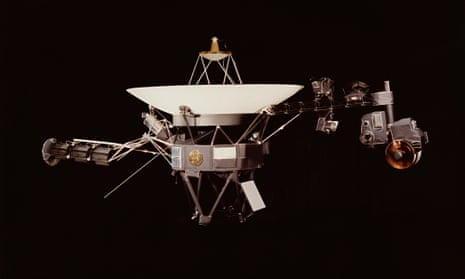
40 years and counting: the team behind Voyager’s space odyssey
In 1977, Voyager 1 and 2 started their one-way journey across our galaxy, travelling a million miles a day. Jonathan Margolis meets the dedicated team keeping the craft moving
O n a chilly March morning, Steve Howard, aged 65, is at work in his office on the northern edge of Pasadena, California. Two computer screens are squeezed on to his corner desk along with family photos, a tissue box and tins of Altoids Curiously Strong Peppermints. The office is in a quiet business park by a workaday main road. Next to it is a McDonald’s, where people linger for hours over a $1 coffee, seemingly to keep warm. Over the road there’s a scruffier burger joint, Jim’s, with an M missing from its sign – and, visible from Howard’s window, a landscaping supplies yard.
If the few people walking by on West Woodbury Road, Altadena, or popping into the landscaping place for some patio paving slabs were to peer into Howard’s office, they might guess, seeing the graph-covered twin screens and a third PC at the other end of the desk, that he was, perhaps, a financial adviser or a day trader. But what Steve Howard is actually doing makes this very ordinary all-American scene quite extraordinary.
Howard is a Nasa mission controller. He is sending instructions to a probe in interstellar space, 12 billion miles from Earth, beyond Pluto and escaping our Solar System at 1 million miles a day. The 815kg craft, Voyager 1 , is one of two identical machines that for many years now have been the furthest human-made objects from Earth. Howard’s computer code takes 17 hours at the speed of light to reach Voyager 1, the furthest travelled. Voyager 2, which is leaving the solar system in a different direction, is 3bn miles closer. The responses, from transmitters on the twin probes running 23 watts of power – have the power of a billionth of a billionth of a watt by the time they reach Earth.
“So here, see, I have Voyager 1’s status and information up, at least as it was 17 hours ago,” Howard explains. “Right now I’m connected to our Canberra station, and these are seven commands, set to radiate one every five minutes starting 30 minutes from now. They’re to verify that the spacecraft can receive and reset its timer. Such is the speed of light, I will not get confirmation that all is OK until late tomorrow night, but it will have entailed a 25bn-mile round trip, so that’s not too bad.”
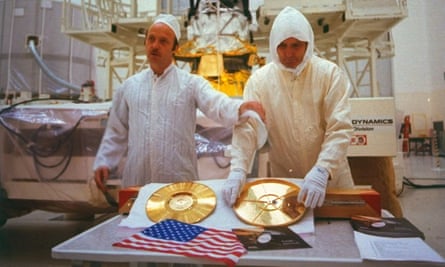
It is no hyperbole to say, then, that the man tapping away at his keyboard on the office park next to McDonald’s is a key figure in the greatest-ever feat of human exploration. There was nothing like the Voyager 1 and 2 missions to the outer planets before they launched in 1977, and although three outer planet probes launched last decade are still on mission, no new ventures into deep space are planned.
Space exploration tends to be more inward looking today than in the so-called Space Age. The famous Curiosity rover is of course still working wonders on Mars, but almost all the US’s coming spacecraft will be restricted to studying our own planet, with special attention to environmental issues. The Voyagers and the people like Howard who still work on them full-time – having, in many cases, done so their entire adult life – are from a different era, when budgets were unrestrained, audaciousness (and showing off to the Soviets) was in vogue and the environment was a concern only for hippies.
Voyager’s spindly limbed, Transit-van-sized machines have been travelling at around 37,000mph for almost 38 years. When they were launched, wooden-framed Morris 1000 Traveller cars had only recently stopped being produced by British Leyland in Oxford. The Voyagers’ on-board computers are early 1970s models that were advanced then but are puny now – an iPhone’s computer is some 200,000 times faster and has about 250,000 times more memory than Voyager’s hardware.
The Voyager mission’s early 70s-inspired and -equipped trip, originally meant to last four years, took the craft initially to Jupiter, then Saturn, then, as a bonus since everything was working well, to Uranus and finally Neptune, after which they spun off into their journey around the Milky Way. Against all expectations their vintage electronics and thrusters are still, mostly, working in the intense -253C cold of outer space. What’s more, their sensors are sending data all day every day, as some will continue to do until 2036. That said, by 2025 almost all the instruments sending worthwhile scientific information will be turned off as the ships’ tiny plutonium-238 power sources dwindle.
The on-board camera on each Voyager, for instance, was deactivated to save power 25 years ago last Valentine’s Day. This was after Voyager 1 took a now-iconic “family portrait” of the solar system from almost 4bn miles out. It captured Neptune, Uranus, Saturn, Jupiter, Venus, Earth (seen, in the late astrophysicist Carl Sagan ’s phrase, as a “pale blue dot”) and the Sun, by then just a tiny point of light. By 2036 the craft will be nearly out of the solar system altogether and will remain dead, although in perfect condition, probably for eternity.
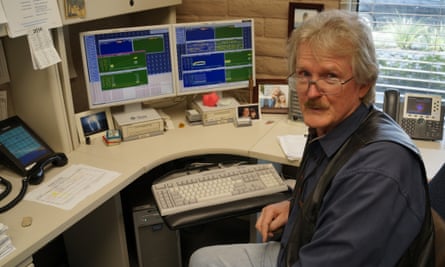
It is the Voyager spacecrafts’ longevity, despite their becoming a bit arthritic in later years, that has led to their Mission Control being moved out to an office park. The problem for Nasa – more correctly for the California Institute of Technology’s Jet Propulsion Laboratory , which runs most robotic missions for Nasa – is that high-profile later expeditions, most notably Curiosity, have used the available space on CalTech’s campus. Proud as JPL is of the amazing Voyager story, the craft are not taking photos or doing a lot of sexy science any more and may not encounter anything of much interest for another 40,000 years, by which time they will be deaf and mute. So, like a great grandfather who stubbornly refuses to do the decent thing, the Earth end of the Voyager programme and the spacecraft’s devoted carers have been put in a somewhat off-piste rest home.
Engineers are not given to emotion, but the romance of this incredible voyage of discovery has, by their own account, kept the ageing mission team together. Even latecomers, who were at school when Voyager was launched, have been working on the same mission for 30 years and more. “I’m in my mid-50s and treat the craft like my ageing parents,” says Suzy Dodd , who was 16 at launch, joined as a graduate student and whose card now proclaims surely one of the cooler job titles in science: Project manager, Voyager Interstellar Mission.
“You treat them with a certain amount of reverence; you know they’re stately spacecraft, venerable senior citizens, and you want to do everything possible for them to have a healthy lifetime,” she says. “You need to help them a bit because things have failed and you want to be careful other things don’t. Most of the engineers here have dedicated their career to this project. They have turned down opportunities for promotions and other things because they like Voyager so much they want to stay with it.”
It is clear talking to Voyager staff that they genuinely love their spacecraft, even though most were too young to see them before they flew, and it is more than possible that the older ones will have died before the Voyagers bleep their last. But as engineers, they have mixed feelings about the most famous aspect of that romance, the “golden record” that each craft carries. This is a gold-covered copper LP, packed with a needle and cartridge (plus instructions), and containing, in groove form, 115 photos from Earth, a selection of natural sounds from surf to whales, music from a variety of cultures and eras (the modern west is represented by Chuck Berry’s “Johnny B Goode”) and spoken greetings in 55 languages, from Akkadian, spoken in Sumer about 6,000 years ago, to Welsh.
Carl Sagan, who had the initial idea for the record, wrote in the 1970s: “The spacecraft will be encountered and the record played only if there are advanced spacefaring civilisations in interstellar space. But the launching of this bottle into the cosmic ocean says something very hopeful about life on this planet.” Sagan’s son Nick, then an infant, now a science-fiction novelist and screenwriter (his credits include Star Trek episodes), recorded the English message: “Hello from the children of planet Earth.” But one sure to make many tear up is the Mandarin: “Hope everyone’s well. We are thinking about you all. Please come here to visit when you have time.” (The messages are on the Voyager website, voyager.jpl.nasa.gov ).
Voyager’s mission controllers are less starry-eyed than Sagan about the golden records. You sense some feel that it was too much of a bow to religious sentiment. Steve Howard is one of the more positive on the record question. “Even though Earth may not be here, some intelligent being could pick it up and detect it. I would say that many of the civilisations are much more advanced and would detect something like that and simply go in and decipher it,” he says.
Suzy Dodd’s view is more typical of the team’s. “I think it’s a great idea to get humans and mankind thinking what-ifs. Let’s send a picture of ourselves vintage 1977 and put it on a spacecraft and send it out there forever. I think it’s done to connect us to the spacecraft more than for an alien running into it. I’m of the opinion that space is very empty and the chances of something finding it are remote. But that doesn’t diminish the fact that we’ve got a little time capsule out there travelling through space and now orbiting around in our galaxy. And that’s us.”
For the mission’s much-honoured chief scientist and spokesman since 1972, CalTech professor Ed Stone, aged 79, the romance of Voyager lies more in what it has discovered since he joined the project aged 36. “Yes, the Space Age was a young man’s game back then,” he says, not a little ruefully, sitting on a park bench on the green university campus. “We all knew we were on a mission of discovery. We just had no idea how much discovery there would be. We just kept finding things we didn’t know were there to be found.
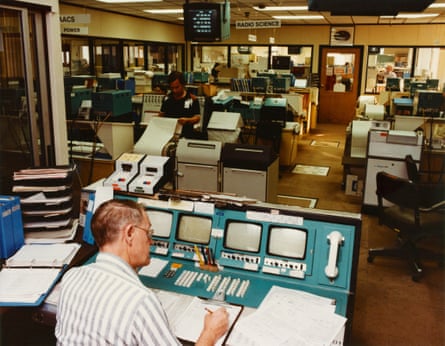
“For example, before Voyager, the only known volcanoes in the solar system were here on Earth. Then we flew by Jupiter’s moon, Io, which had 10 times the volcanic activity of Earth. Ten times! We detected hot lakes of lava on the surface. That was the first major discovery and it set the tone for the rest of the mission. And there are five instruments still working. But by 2025 the last will go off.”
He doesn’t quite add that by then he will be nearly 90, but does say, smiling: “Thing is, if you want to do space experiments, you have to be optimistic that it’s all going to work and that you’re going to find something worth the work. And you have to be patient, because nothing happens fast in space.”
Stone explains how, although it’s widely considered freakish that the Voyager crafts are still working so well – a TV left permanently on since Jim Callaghan’s day would be hardly working today – it’s less surprising to people like him who built them. To anyone familiar with the inside of a vintage radio or TV, the hand-soldered circuit boards, capacitors, transistors, resistors and so on that run a Voyager would look reassuringly familiar, which isn’t the case with a modern computer or phone, whose microchip-studded innards look more like something out of a UFO.
But the parts in Voyager weren’t as ordinary as they looked. Suzy Dodd, a “newcomer” to the project with just over 30 years’ service, has also been intrigued by the spacecraft’s durability. “The robustness is unique,” she says. “If you talk to the older engineers, they’ll say: ‘Well, we were told to make a four-year mission, but we realised if you just used this higher-rated component, it would last twice as long.’ So they did that. They just didn’t tell anybody. The early engineers were very conscious of trying to make this last as long as possible and, quite frankly, being not as forthcoming with information about the types of parts they were using.”
Even so, Ed Stone says, there have been problems. A ground controller’s error in April 1978 meant that Voyager 2 switched itself irretrievably to its back-up receiver – meaning that the craft has been receiving transmissions from Earth on a dodgy back-up radio for almost the entire mission. One of the original thrusters also failed.
For spacecraft 12bn miles from home and in their dotage, the Voyagers are quite tranquil machines today, but they do need watching. As Steve Howard is in his office inputting code in primordial programming language, on the floor of what passes for the main mission control Enrique Medina, 65, is watching streams of engineering data from the craft. A computer engineer, Medina is another of the eight full- and part-time controllers.
“One of us is always on call,” he says. “We’re all connected all the time by our smartphones. We will hear, that way, which engineering channel is out of tolerance and then we will connect from home with secure IDs and special codes, troubleshoot, determine and sometimes fix it from home. Or in some cases, one of us will drive in. That usually happens four to five times a month.
“Sometimes people are away, but we love Voyager so much that though it’s not part of our employment we’ll come in and do it anyway. Attitude control is my sub-system, but if the propulsion or the power needs attention, we all do multiple jobs,” he adds. “I’ve been working on Voyager since the Uranus encounter in 1986, and I will retire when Voyager retires in 2025. My wife doesn’t like that idea at all, as we already have a retirement place by the beach back in Mexico.”
Medina’s devotion to the Voyager is clear to see. “This has been part of my life for so long, and they pay us to do it, so how can you stop doing something you love? I even talk about the spacecraft like it’s a person, especially if it’s my sub-system.”
Steve Howard feels the same. “I just love to think of everything, all those 65,000 parts on each craft, working up there,” he says. “Oh man, it really is something. Every time we come in here, it’s just a gift. And you know that one day it could stop.”
Do these engineers ever think it might be more fun to be at the controls of Curiosity on the CalTech campus a couple of miles away?
“Yes, maybe,” says Medina, “but after so many years, you’re invested. It’s like being married to someone. It would be interesting to go out with Angelina Jolie, but do I want to give up my wife of 44 years, and my grandkids? I don’t think so. I would not give this up for something more interesting or newer.”
For the most part, Voyager is the reality of space – slow, patient science, humdrum perhaps, but real. It’s only a 20-minute drive from Altadena to Hollywood, where brilliant fake versions of space exploration like Christopher Nolan’s recent Interstellar are confected.
But Voyager, starring real people who keep tissues and tins of Altoids on their desks and real buildings rather than set designers’ glamorous fantasies, just happens to be the only real interstellar mission there will probably be in the lifetime of anyone alive today. It is surely one of the most amazing things in human history.
Follow the Observer Magazine on Twitter @ObsMagazine
- The Observer
Comments (…)
Most viewed.
Voyagers Continues to Returns Data from The Edges of the Milky Way

More than two years after Voyager 2 looked Neptune's Great Dark Spot in the eye and darted past the frozen surface of its moon Triton, both Voyager spacecraft are continuing to return data about interplanetary space and some of our stellar neighbors near the edges of the Milky Way.
After the Voyager spacecraft flew by the four giant outer planets -- Jupiter, Saturn, Uranus and Neptune -- their mission might have been over. But, in fact, these 14-year-old twins are just beginning a new phase of their journey, called the Voyager Interstellar Mission (VIM).
As the Voyagers cruise gracefully in the solar wind, their fields, particles and waves instruments are studying the space around them while searching for the elusive heliopause -- the outer edge of our solar system.
The heliopause is the outermost boundary of the solar wind, where the interstellar medium restricts the outward flow of the solar wind and confines it within a magnetic bubble called the heliosphere. The solar wind is made up of electrically charged atomic particles, composed primarily of ionized hydrogen, that stream outward from the Sun. "The termination shock is the first signal that we are approaching the heliopause. It's the area where the solar wind starts slowing down," said Voyager Project Scientist and JPL's Director, Dr. Edward C. Stone. Mission scientists now anticipate that the spacecraft may cross the termination shock by the end of the century. Exactly where the heliopause is remains a mystery. Its long been thought to be located some 75 to 150 astronomical units (AU) from the Sun. (One AU is equal to 150 million kilometers (93 million miles), or the distance from the Earth to the Sun.) Any speculation about where the heliopause is or what it is like, has come only from computer models and theories. "Voyager 1 is likely to return the first direct evidence from the heliopause and what lies beyond it," Stone said.
Yet the Voyagers are not sitting idly by as they wait to cross over into interstellar space. Both spacecraft are involved in an extensive program of ultraviolet astronomy that allows them to study active galaxies, quasars and white dwarf stars, in ways unlike any other spacecraft or telescope in existence.
Voyager's ultraviolet spectrometers are the only way scientists can currently observe celestial objects in a unique region in the short end of the ultraviolet portion of the electromagnetic spectrum. "Voyager's instruments allow it to observe things at wavelengths that are for the most part unavailable to other spacecraft," said Dr. Jay Holberg, a member of Voyager's ultraviolet subsystem team.
The Voyagers have become space-based ultraviolet observatories and their unique location in the universe gives astronomers the best vantage point they have ever had for looking at celestial objects that emit ultraviolet radiation. "The light that Voyager is sensitive to has to be observed in outer space," said Holberg.
Voyager's ultraviolet instruments are best suited to study the two extreme phases of a star's life -- its birth and its death. Thus the Voyagers are currently gathering data on early blue stars as well as other white dwarf stars nearing the end of their lifetime. "Voyager is helping us get a better handle on exactly how much energy these hot stars emit," Holberg said.
Now that Voyager's primary mission of exploring the outer planets is over, there are fewer constraints on the science team when it comes to programming the spacecrafts' observations. "We can sit on these things for very long periods of time and watch these stars go through their phases," Holberg said.
Stars can be very active, but also unpredictable. "We don't know when a star will do something. If we want to sit there and wait, we can do it in the hopes that the star will go through an outburst and Voyager will be there to observe it," he continued. Voyager can now stare at an object for days and even weeks at a time to thoroughly map it and the region around it.
Since the beginning of the interstellar mission, the Voyager project has been conducting a guest observer program which allows astronomers from around the world to make proposals and apply for time to use the Voyager ultraviolet spectrometer in much the same way that astronomers apply for time at ground-based observatories. This program enables scientists to make simultaneous observations of the same object using Voyager and ground-based telescopes.
The cameras on the spacecraft have been turned off and the ultraviolet instrument is the only experiment on the scan platform that is still functioning. Voyager scientists expect to continue to receive data from the ultraviolet spectrometers at least until the year 2000. At that time, there will not be enough electrical power for the heaters to keep the ultraviolet instrument warm enough to operate.
Yet there are several other fields and particle instruments that can continue to send back data as long as the spacecraft stay alive. They include: the cosmic ray subsystem, the low-energy charged particle instrument, the magnetometer, the plasma subsystem, the plasma wave subsystem and the planetary radio astronomy instrument. Barring any catastrophic events, JPL should be able to retrieve this information for at least the next 20 and perhaps even the next 30 years.
"In exploring the four outer planets, Voyager has already had an epic journey of discovery. Even so, their journey is less than half over with more discoveries awaiting the first contact with interstellar space," Stone said. "The Voyagers revealed how limited our imaginations really were about our solar system, and I expect that as they continue toward interstellar space, they will again surprise us with unimagined discoveries of this never-before-visited place which awaits us beyond our planetary neighborhood."
Voyager 1 is now 7 billion kilometers (4.3 billion miles) from Earth, traveling at a heliocentric velocity of 63,800 km/hr (39,700 mph). Voyager 2, traveling in the opposite direction from its twin, is 5.3 billion kilometers (3.3 billion miles) from Earth with a heliocentric velocity of 59,200 km/hr (36,800 mph).
The Voyager Interstellar Mission is managed by JPL and sponsored by NASA's Office of Space Science and Applications, Washington, DC.
Voyager turns 45: What the iconic mission taught us and what's next
Can the first probe to visit Neptune and Uranus make it to its 50th anniversary?
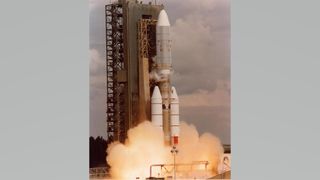
Forty-five years ago, on Aug. 20, 1977, NASA's Voyager 2 spacecraft launched from Cape Canaveral, Florida, on a Titan III-Centaur rocket, embarking on a "grand tour" of the solar system that would include visits to the Jupiter and Saturn systems and would make it the first spacecraft to visit the ice giants Uranus and Neptune and their moons.
Voyager 2 is now 12.1 billion miles (19.5 billion kilometers) away and still sending back data on the distant and unknown heliopause, and scientists are beginning to wonder how long the iconic space probe can keep going.
Designed to take advantage of a once-every-176-years alignment in the 1970s that made it possible for spacecraft to take gravity-assist slingshots from planet to planet across the solar system , the Voyager mission consisted of two probes. Voyager 2 was the first to launch, with Voyager 1 following two weeks later. Both carried the famous " Golden Record ," a 12-inch gold-plated copper disc containing sounds and images portraying the diversity of life and culture on Earth .
Now over 14.5 billion miles (23.3 billion km) away, Voyager 1 is the farthest artificial object from Earth. But Voyager 2 is arguably more iconic because of its incredible multidecade tour of the giant planets.
Related: Celebrate 45 years of Voyager with these amazing images of our solar system (gallery)
Voyager's "grand tour"
Though it launched second, Voyager 1 was so called because it was to reach Jupiter and Saturn first — in March 1979 and November 1980, respectively — before exiting the plane of the planets where it took the famous "Pale Blue Dot" photo . Voyager 2 visited four planets: Jupiter in July 1979, Saturn in August 1981, Uranus in January 1986 and Neptune in August 1989.
"Both Voyager 1 and Voyager 2 provided tremendous legacies for planetary exploration," Jonathan Lunine, a planetary scientist and physicist at Cornell University who is working on the Juno , Europa Clipper and James Webb Space Telescope missions, told Space.com. "Not only in what they accomplished in terms of science, but also demonstrating that it was really possible to explore the outer solar system with a couple of spacecraft."
Get the Space.com Newsletter
Breaking space news, the latest updates on rocket launches, skywatching events and more!
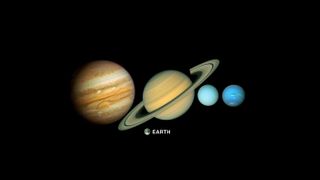
What did the Voyager probes reveal?
Voyager's discoveries are the stuff of legend among planetary scientists, many of whom still rely on the unique images from the spacecraft's wide-angle and narrow-angle cameras. The probes spotted volcanoes on Jupiter's moon Io , discovered that Jupiter's Great Red Spot is an Earth-size storm and found that the gas giant has faint rings. They studied Saturn's rings ; saw the giant moon Titan's thick, Earth-like atmosphere; and revealed the tiny moon Enceladus to be geologically active.
Voyager 2 alone then visited Uranus and Neptune. The spacecraft's first-ever images of Uranus revealed dark rings, the planet's tilted magnetic field and its geologically active moon Miranda. Neptune, meanwhile, was also discovered to have rings and many more moons than scientists initially thought. We also got to see Triton , a geologically active moon that is orbiting "backward" and, like Pluto , is now believed to be a captured dwarf planet from the Kuiper Belt .
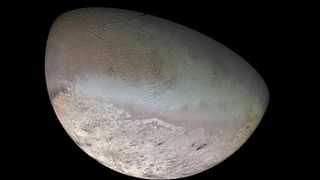
Voyager as a catalyst
In addition to making groundbreaking discoveries, the Voyager mission helped scientists determine what merited deeper exploration. The mission revealed Jupiter to be an incredibly complex planet, thus spurring NASA to launch the Galileo mission in 1989 and the Juno mission in 2011. The Voyager probes' work also helped to inspire the iconic Cassini mission to Saturn.
"Voyager 1's close flyby of Titan was the catalyst for the wonderful Cassini mission to Saturn and its Huygens probe," Lunine said. The Huygens probe landed on the surface of Titan in 2005 and sent back an incredible video .
Voyager 2 has also been a catalyst for investigations into the role of the ice giant planets — not only in the solar system but also in distant star systems, since most of the exoplanets found so far are roughly the size of Neptune and Uranus.
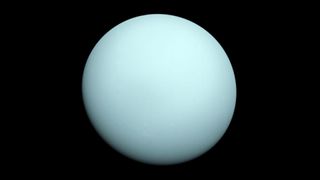
Voyager and NASA today
NASA has spent decades following up on the Voyager missions, and those efforts continue today. The space agency's Dragonfly mission will reach Titan, Saturn's largest moon, in 2034, while Europa Clipper will study Jupiter's ocean moon, first imaged by Voyager, starting in 2030. In April, the National Academies Planetary Science Decadal Survey recommended that NASA send a $4.2 billion Uranus Orbiter and Probe mission to unveil the mysterious ice giant planet and its moons in the 2040s.
It's the latest mission that's a direct consequence of Voyager 2's brief visit to the Uranus system in January 1986. "Voyager 2's flyby of Uranus was a bull's-eye — it went directly through the plane of the moons' orbits because of the orientation of Uranus' axis to the sun ," Lunine said. That made it unlike flybys at other planets, where the probes were able to visit one moon after another. "Voyager 2 got very brief images from these moons, so they're largely unexplored," Lunine said.
Ariel and Miranda, in particular, are thought to be ocean worlds and so would be specifically targeted by the Uranus Orbiter and Probe. "It's been 45 years since the launch of Voyager 1 and Voyager 2, and here we are now finally talking about a Uranus Orbiter and Probe mission," Lunine said. "It seems like a long time because these missions take so long to conceive of, fund, build, launch and execute, but it all comes from the intriguing peeks that we got from Voyager 2."
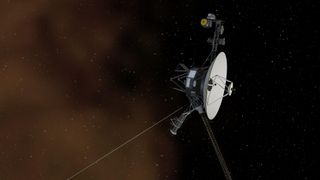
How long will Voyager last?
Both Voyager 1 and Voyager 2 still communicate with NASA's Deep Space Network (which itself was created to communicate with Voyager 2 at Uranus and Neptune), receiving routine commands and occasionally transmitting data to Earth. "We are still getting data from Voyager," Stamatios Krimigis, principal investigator for the Voyager 1 and 2 probes and the Voyager Interstellar Mission, said during a news conference held at COSPAR 22 in July. "We're looking forward to getting data for probably another five or six years."
— What's next for NASA's Voyager 2 in interstellar space?
— Scientists' predictions for the long-term future of the Voyager Golden Records will blow your mind
— NASA's twin Voyager probes are nearly 45 — and facing some hard decisions
Around the mid- to late 2020s , the probes' scientific instruments will be entirely switched off, and eventually, the spacecraft will go cold and silent — but their journeys into interstellar space will continue indefinitely. "My motto is, I want to be here after Voyager passes on," said Krimigis, who is in his 80s. "But I'm not sure that's going to happen."
In around 300 years, Voyager 1 and 2 will enter the Oort cloud , the sphere of comets surrounding the solar system. About 30,000 years later, they'll exit the neighborhood and silently orbit the center of the Milky Way for millions of years.
Their scientific work may be almost over, but the Voyager spacecraft have only just begun their journeys into the cosmos.
Follow us on Twitter @Spacedotcom and on Facebook .
Join our Space Forums to keep talking space on the latest missions, night sky and more! And if you have a news tip, correction or comment, let us know at: [email protected].

Jamie is an experienced science, technology and travel journalist and stargazer who writes about exploring the night sky, solar and lunar eclipses, moon-gazing, astro-travel, astronomy and space exploration. He is the editor of WhenIsTheNextEclipse.com and author of A Stargazing Program For Beginners , and is a senior contributor at Forbes. His special skill is turning tech-babble into plain English.
Satellites watch as 4th global coral bleaching event unfolds (image)
Happy Earth Day 2024! NASA picks 6 new airborne missions to study our changing planet
Satellites spot clusters of 'spiders' sprawled across Mars' Inca City (photo)
Most Popular
- 2 5 sci-fi movies that weren't great but still deserve a sequel
- 3 NASA begins delivering 1st Artemis Moon Trees to be planted across United States
- 4 Superheroes fight acid-spewing xenomorphs in Marvel Comics' 'Aliens vs. Avengers'
- 5 James Webb Space Telescope discovers some early universe galaxies grew up surprisingly fast

The most distant human-made object

No spacecraft has gone farther than NASA's Voyager 1. Launched in 1977 to fly by Jupiter and Saturn, Voyager 1 crossed into interstellar space in August 2012 and continues to collect data.
Mission Type
What is Voyager 1?
Voyager 1 has been exploring our solar system for more than 45 years. The probe is now in interstellar space, the region outside the heliopause, or the bubble of energetic particles and magnetic fields from the Sun.
- Voyager 1 was the first spacecraft to cross the heliosphere, the boundary where the influences outside our solar system are stronger than those from our Sun.
- Voyager 1 is the first human-made object to venture into interstellar space.
- Voyager 1 discovered a thin ring around Jupiter and two new Jovian moons: Thebe and Metis.
- At Saturn, Voyager 1 found five new moons and a new ring called the G-ring.
In Depth: Voyager 1
Voyager 1 was launched after Voyager 2, but because of a faster route, it exited the asteroid belt earlier than its twin, having overtaken Voyager 2 on Dec. 15, 1977.
Voyager 1 at Jupiter
Voyager 1 began its Jovian imaging mission in April 1978 at a range of 165 million miles (265 million km) from the planet. Images sent back by January the following year indicated that Jupiter’s atmosphere was more turbulent than during the Pioneer flybys in 1973–1974.
Beginning on January 30, Voyager 1 took a picture every 96 seconds for a span of 100 hours to generate a color timelapse movie to depict 10 rotations of Jupiter. On Feb. 10, 1979, the spacecraft crossed into the Jovian moon system and by early March, it had already discovered a thin (less than 30 kilometers thick) ring circling Jupiter.
Voyager 1’s closest encounter with Jupiter was at 12:05 UT on March 5, 1979 at a range of about 174,000 miles (280,000 km). It encountered several of Jupiter’s Moons, including Amalthea, Io, Europa, Ganymede, and Callisto, returning spectacular photos of their terrain, opening up completely new worlds for planetary scientists.
The most interesting find was on Io, where images showed a bizarre yellow, orange, and brown world with at least eight active volcanoes spewing material into space, making it one of the most (if not the most) geologically active planetary body in the solar system. The presence of active volcanoes suggested that the sulfur and oxygen in Jovian space may be a result of the volcanic plumes from Io which are rich in sulfur dioxide. The spacecraft also discovered two new moons, Thebe and Metis.
Voyager 1 at Saturn
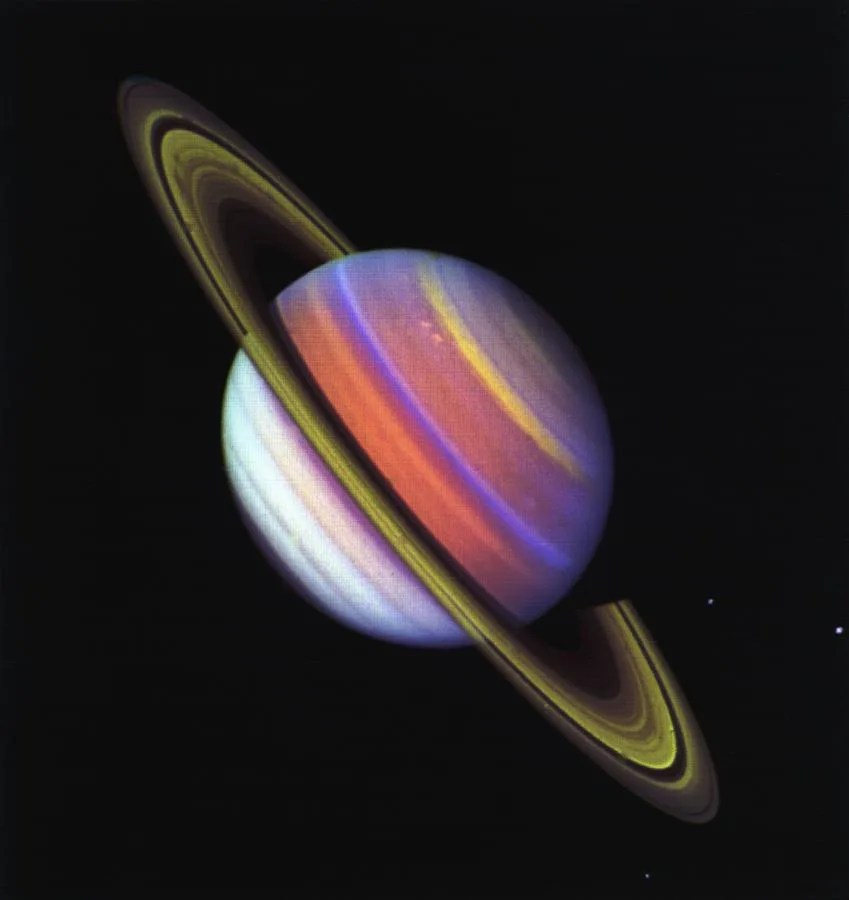
Following the Jupiter encounter, Voyager 1 completed an initial course correction on April 9, 1979 in preparation for its meeting with Saturn. A second correction on Oct. 10, 1979 ensured that the spacecraft would not hit Saturn’s moon Titan.
Its flyby of the Saturn system in November 1979 was as spectacular as its previous encounter. Voyager 1 found five new moons, a ring system consisting of thousands of bands, wedge-shaped transient clouds of tiny particles in the B ring that scientists called “spokes,” a new ring (the “G-ring”), and “shepherding” satellites on either side of the F-ring—satellites that keep the rings well-defined.
During its flyby, the spacecraft photographed Saturn’s moons Titan, Mimas, Enceladus, Tethys, Dione, and Rhea. Based on incoming data, all the moons appeared to be composed largely of water ice. Perhaps the most interesting target was Titan, which Voyager 1 passed at 05:41 UT on November 12 at a range of 2,500 miles (4,000 km). Images showed a thick atmosphere that completely hid the surface. The spacecraft found that the moon’s atmosphere was composed of 90% nitrogen. Pressure ad temperature at the surface was 1.6 atmospheres and 356 °F (–180°C), respectively.
Atmospheric data suggested that Titan might be the first body in the solar system (apart from Earth) where liquid might exist on the surface. In addition, the presence of nitrogen, methane, and more complex hydrocarbons indicated that prebiotic chemical reactions might be possible on Titan.
Voyager 1’s closest approach to Saturn was at 23:46 UT on 12 Nov. 12, 1980 at a range of 78,000 miles(126,000 km).
Voyager 1’s ‘Family Portrait’ Image
Following the encounter with Saturn, Voyager 1 headed on a trajectory escaping the solar system at a speed of about 3.5 AU per year, 35° out of the ecliptic plane to the north, in the general direction of the Sun’s motion relative to nearby stars. Because of the specific requirements for the Titan flyby, the spacecraft was not directed to Uranus and Neptune.
The final images taken by the Voyagers comprised a mosaic of 64 images taken by Voyager 1 on Feb. 14, 1990 at a distance of 40 AU of the Sun and all the planets of the solar system (although Mercury and Mars did not appear, the former because it was too close to the Sun and the latter because Mars was on the same side of the Sun as Voyager 1 so only its dark side faced the cameras).
This was the so-called “pale blue dot” image made famous by Cornell University professor and Voyager science team member Carl Sagan (1934-1996). These were the last of a total of 67,000 images taken by the two spacecraft.
Voyager 1’s Interstellar Mission
All the planetary encounters finally over in 1989, the missions of Voyager 1 and 2 were declared part of the Voyager Interstellar Mission (VIM), which officially began on Jan. 1, 1990.
The goal was to extend NASA’s exploration of the solar system beyond the neighborhood of the outer planets to the outer limits of the Sun’s sphere of influence, and “possibly beyond.” Specific goals include collecting data on the transition between the heliosphere, the region of space dominated by the Sun’s magnetic field and solar field, and the interstellar medium.
On Feb. 17, 1998, Voyager 1 became the most distant human-made object in existence when, at a distance of 69.4 AU from the Sun when it “overtook” Pioneer 10.
On Dec. 16, 2004, Voyager scientists announced that Voyager 1 had reported high values for the intensity for the magnetic field at a distance of 94 AU, indicating that it had reached the termination shock and had now entered the heliosheath.
The spacecraft finally exited the heliosphere and began measuring the interstellar environment on Aug. 25, 2012, the first spacecraft to do so.
On Sept. 5, 2017, NASA marked the 40th anniversary of its launch, as it continues to communicate with NASA’s Deep Space Network and send data back from four still-functioning instruments—the cosmic ray telescope, the low-energy charged particles experiment, the magnetometer, and the plasma waves experiment.
The Golden Record

Each of the Voyagers contain a “message,” prepared by a team headed by Carl Sagan, in the form of a 12-inch (30 cm) diameter gold-plated copper disc for potential extraterrestrials who might find the spacecraft. Like the plaques on Pioneers 10 and 11, the record has inscribed symbols to show the location of Earth relative to several pulsars.
The records also contain instructions to play them using a cartridge and a needle, much like a vinyl record player. The audio on the disc includes greetings in 55 languages, 35 sounds from life on Earth (such as whale songs, laughter, etc.), 90 minutes of generally Western music including everything from Mozart and Bach to Chuck Berry and Blind Willie Johnson. It also includes 115 images of life on Earth and recorded greetings from then U.S. President Jimmy Carter (1924– ) and then-UN Secretary-General Kurt Waldheim (1918–2007).
By January 2024, Voyager 1 was about 136 AU (15 billion miles, or 20 billion kilometers) from Earth, the farthest object created by humans, and moving at a velocity of about 38,000 mph (17.0 kilometers/second) relative to the Sun.

National Space Science Data Center: Voyager 1
A library of technical details and historic perspective.

Beyond Earth: A Chronicle of Deep Space Exploration
A comprehensive history of missions sent to explore beyond Earth.
Discover More Topics From NASA

Our Solar System

- Recent Photos
- The Commons
- Flickr Galleries
- Camera Finder
- Flickr Blog
- The Print Shop
- Prints & Wall Art
- Photo Books
- Stats Dashboard
- Get Auto-Uploadr

An 15.4" inch laptop from work (military though-book)
Centrino 1.7ghz, 1gb ram, paradigit voyager "rock solid", titanium, black magnesium shielding, military style, 3.5kg,15.4 inch sxga+ (1400 x 1050), paradigit rocksolid 9160.
This site has limited support for your browser. We recommend switching to Edge, Chrome, Safari, or Firefox.
FROM THE MOUNTAINS, TO THE BEACHES & EVERYWHERE IN BETWEEN - WELCOME TO PARKIT
SIGN UP FOR 10% OFF YOUR FIRST ORDER
OVER 400+ ★★★★★ REVIEWS
INVEST IN ADVENTURE + FREE USA SHIPPING & 24-MONTH WARRANTY

- VOYAGER CHAIR
- VOYAGER SAGUARO (New)
- VOYAGER LTE
- ACCESSORIES
- WHY VOYAGER
- ABOUT PARKIT
- OUR COMMITMENT
- CAMPFIRE STORIES
- Create account
Cart 0 items
Sorry, looks like we don't have enough of this product.
Shipping & taxes calculated at checkout
Browse categories

Your email has been received.

BUY MORE, SAVE MORE
2-pack (buy-1 get-1 25% off), 4-pack (buy-2 get-2 30% off).
5x Sold Out - Lock In Your Favorite Styles For 2024 Adventures --- *SLATE, SAGUARO, CLASSIC BLUE, CALICO ON PRE-ORDER | SHIPPING EST: LATE-APRIL '24 *GLACIER & TROPIC | SOLD OUT!
Enjoy the Exploration with Voyager from PARKIT. This outdoor recreational-use chair has been designed to provide maximum comfort, ultimate durability, and fundamental functionality to relax in the great outdoors. A cooler-chair combo with storage for anything you need under your seat, a versatile cupholder, hands-free carry straps and more, VOYAGER is built to last, adventure after adventure.
FUNDAMENTAL FUNCTIONALITY
INSULATED COOLER / UTILITY STORAGE | Designed to hold ice for 8+ hours, storage for what you enjoy, and includes exterior pockets to securely carry all items to and from your basecamp.
HANDS FREE CARRY | Hands-free-carry strap(s) that gives your hands the freedom to carry whatever the day demands + Double Pack (Fold and Carry) that secures those extra items needed at your destination. Learn more below.
INTERCHANGEABLE CUP HOLDER | Cup holder fixtures built into either side of the framing (left/right) with cutouts designed for cans, insulated water bottles, and coffee mugs.
ICONIC DESIGN + CLASSIC COMFORT
SIT WHERE YOU'RE SUPPOSED TO SIT. Somewhere along the way, we decided to sit as low to the ground as possible. Turns out that’s bad for your physical well-being. We’ve designed the VOYAGER to be conscientious to our natural sitting position. Sit 16" off the ground with Voyager.
SUPERIOR CRAFTSMANSHIP
INDUSTRIAL FRAMING | We've sourced Aircraft-Grade Aluminum for the foundation of the Voyager. Strength, durability, and resilience in every use.
WOVEN POLYESTER WEBBING | Our unique fabric design is made from woven polyester which is soft to the touch and maintains strength to keep that “like new” comfort.
FAUX TEAK ARMREST | Durable, Teak-like material to add that extra touch of style to any fireside campout.
PARKIT + SEATREES
1 MANGROVE TREE PLANTED FOR EVERY VOYAGER PURCHASED. Every chair sold by PARKIT means a new opportunity for SeaTrees to plant a Mangrove and reach their goal of planting 1 million trees. Each tree is cared for and grown by the local communities to pave the way for a sustainable future.
WE STAND BEHIND OUR PRODUCTS
Which is why PARKIT offers a warranty of 24-months from the date of receipt. If you experience any issues due to defects in materials and workmanship, we’ll either repair or replace your product. Learn More

WILDLY FUNCTIONAL

SIMPLE & PORTABLE
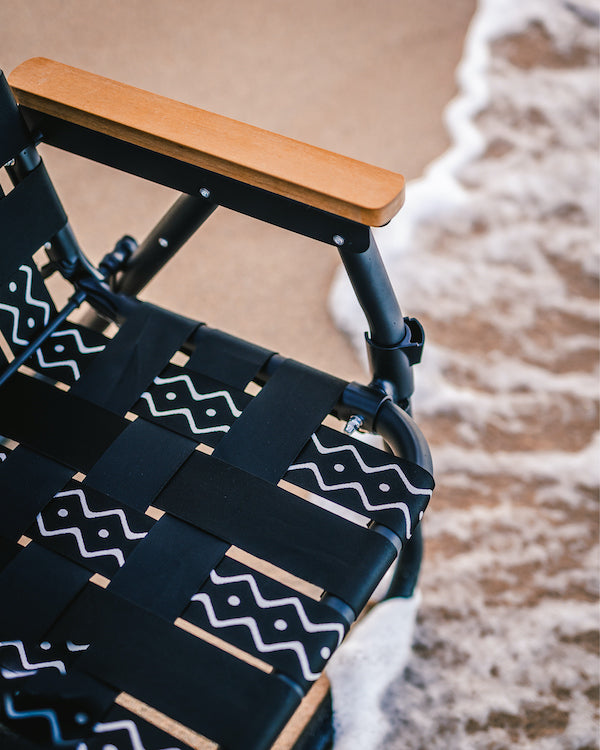
ICONIC STYLE
5X SOLD OUT RESERVE THE EARLIEST SHIP DATES
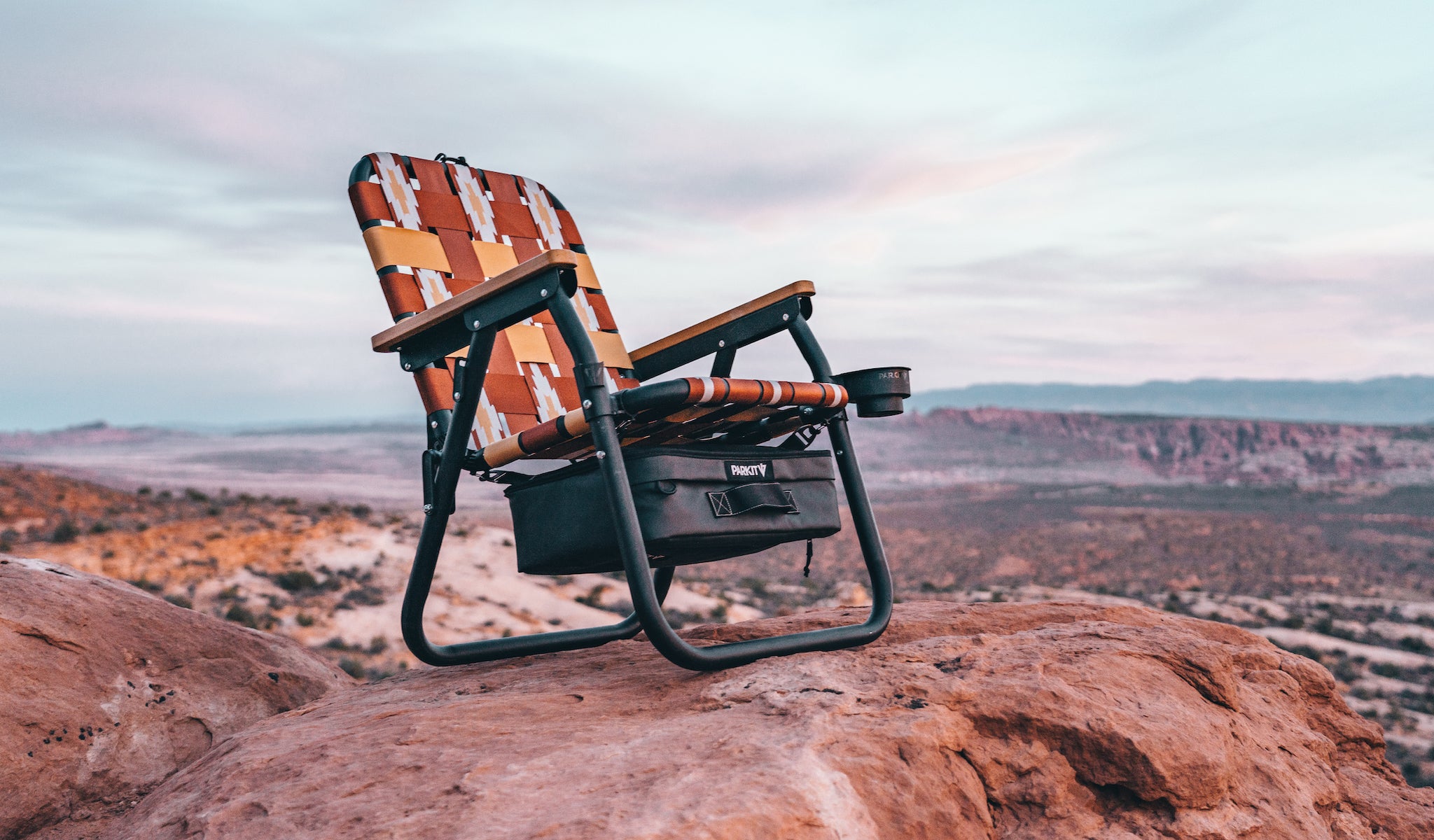
Fundamental Functionality
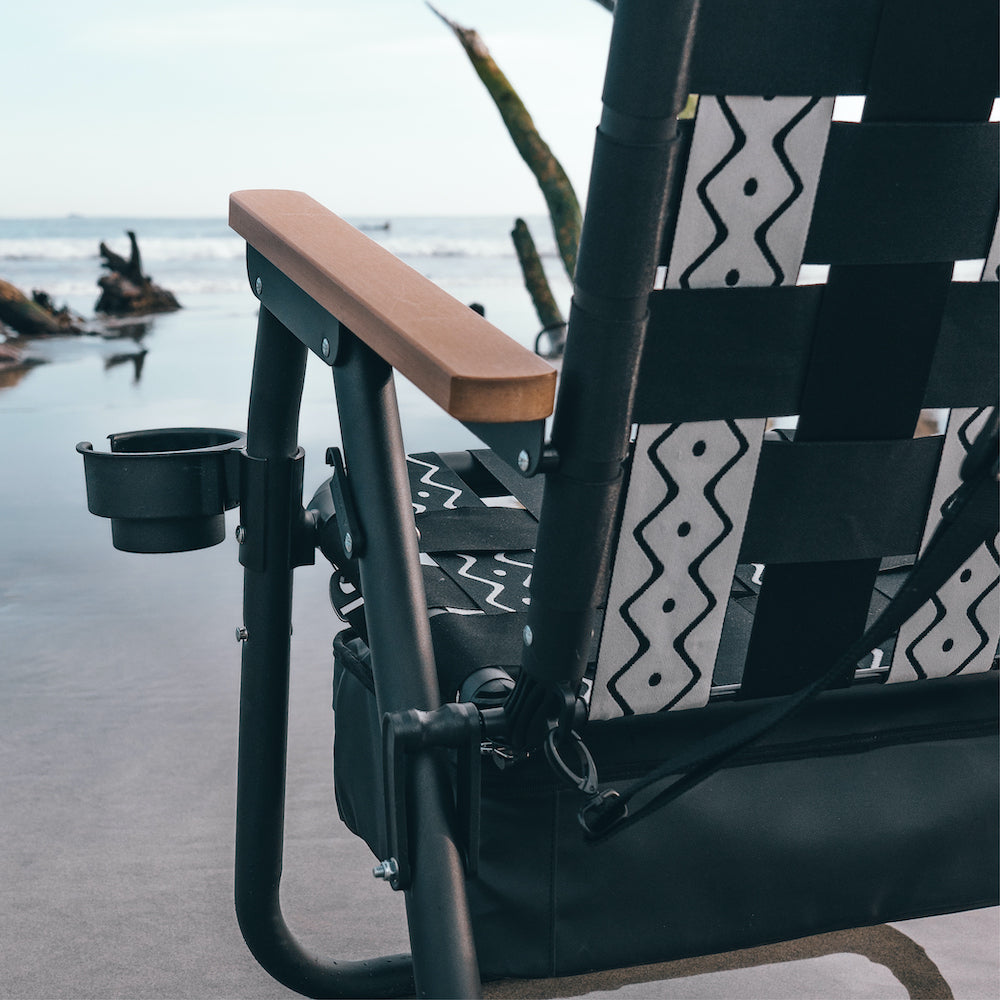
Durability In Each Component.
VOYAGER boast a lightweight, rust-free aerospace grade aluminum frame with a 350lb weight capacity. The arm rest are sourced from the same wood-like material as modern day boat docks and outdoor patios. Lastly, all engineered movement occurs inside casted joints that protect important mechanical elements ensuring years of use.

Ergonomically Designed Comfort
Free shipping.
On All Voyager Products

30 Day Returns
Our Satisfaction Gaurentee.
24-Month Warranty
We stand behind our products, so you can sit without worry.
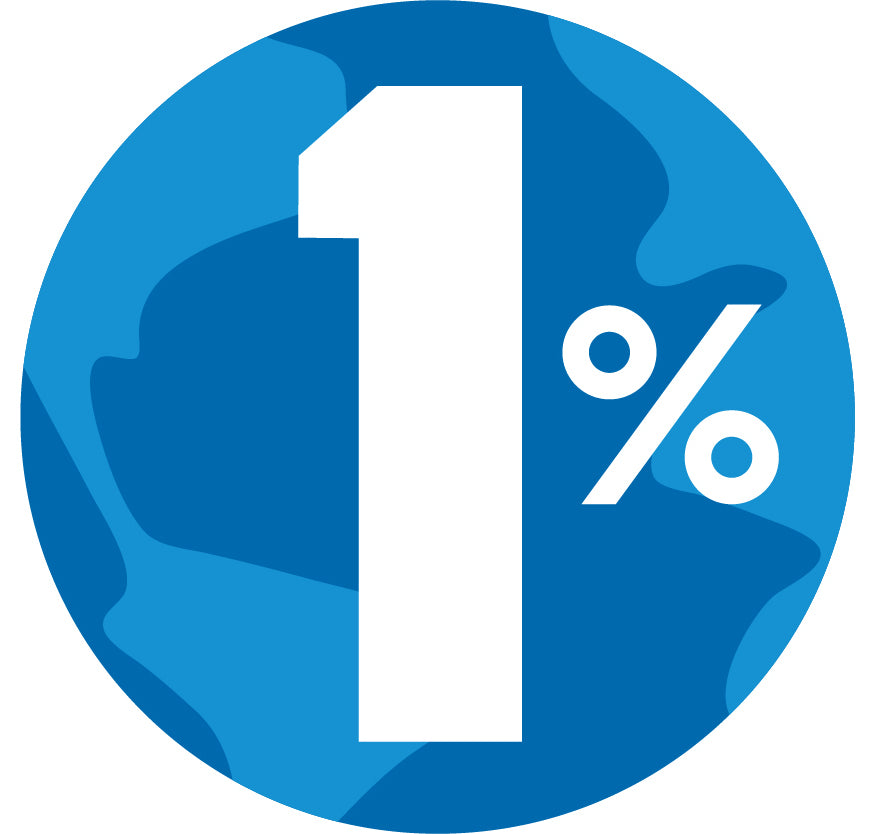
1% Donated Annually
Certified Partner of 1% For The Planet
People Have Asked
Everything you need to enjoy at your next campout - s'mores ingredients come separately. (1) Chair, (1) Cooler, (1) Cupholder and (1) Set of carry straps.
Our chairs have a weight capacity of 350 lbs and the chair itself weighs 12 lbs with an empty cooler. The Voyager chair dimensions are: - Total Height: 32" - Seat Height: 16" - Backrest Height: 21" - Total Width: 22.5" - Seating Area Width: 20.5" - Seating depth: 16"
Yes! We're proud to support our troops and local community members. Learn more.
We get this questions a lot so figured we'd add it here too - the box located under the seat is an insulated and welded cooler that will maintain ice for 8+ hours. It also has enough space for 15, 12oz cans of your favorite beverage. The cooler can also serve as utility storage as it has 2 exterior pockets that are perfect for keys, sunglasses, suncreens etc.
Customer Reviews
Avast ye shoppers! The VOYAGER chair from PARKIT be a true treasure in the vast sea of outdoor seating. This maritime marvel, with its sturdy construction, be akin to a well-rigged ship weathering the roughest of seas. The weather-resistant materials are as resilient as a ship's hull, standing tall against the salty air and harsh sun. The comfort it provides be smoother than a calm ocean breeze, making it the perfect port for weary souls. Anchors aweigh to PARKIT for crafting the VOYAGER – a flagship chair that navigates the waters of comfort and durability with the finesse of a seasoned captain. Fair winds and a comfy seat to all who embark on this maritime adventure!
My expectations were all over the place after I bought these chairs. I honestly didn't know if I had made one of the best outdoor/chair purchases of all time or just got swindled into buying a jazzed up version of my dead grandma's beach chair. With complete confidence I can tell you it's the first one! 🤣
The chair lives up to and exceeds the hype. I still remember how ridiculous I probably looked lowering myself to sit in the chair (think man discovering fire); I fully expected to hear a creak or feel the chair give a little bit, but nothing. Not a peep. I exhaled like I had just defused a bomb and rightfully so. Now I can relax because I have an sick looking chair (chairs.. Bought a few) that will come with me and my family for years to come. Thanks guys! Keep up the awesome work.. And please make a pint-sized one for the kids soon.
So I play a lot of beach volleyball @ surfing .And just lately I’ve been not doing so well with beach chairs . Them breaking on me or just falling apart completely ., By chance I was searching on the Internet. Read the story so I went out and ordered one.. and the chair is awesome and I’m getting comments left and right from people. I must’ve given out to some locals friends and family your website 15 times.. Because after they sat down on the chair, most of them wanted to take it home, or offer me money on the spot for it. You guys rock!!!!!!
These are, by far, the coolest, most versatile, best-looking chairs out there! Whether we're going to a sports event or to the beach, our PARKIT chairs are easy to carry, have the best cooler and cup holder, and people constantly stop to ask us where we got them. Highly recommend!
Fantastic product. Fantastic company. 10 out of 10 would recommend. I was initially worried about the cost, but theses have proved to be worth every penny.

#EnjoyTheExploration
You may also like....

VOYAGER CUPHOLDER $19.99 USD
Two cupholders mean many things to many different people. For some, it means 2 drinks! For others, 2 cupholders might mean a drink on the left and a phone on the right. Heck, you could even put your blue tooth speaker in the additional cupholder (if it fits that is)!
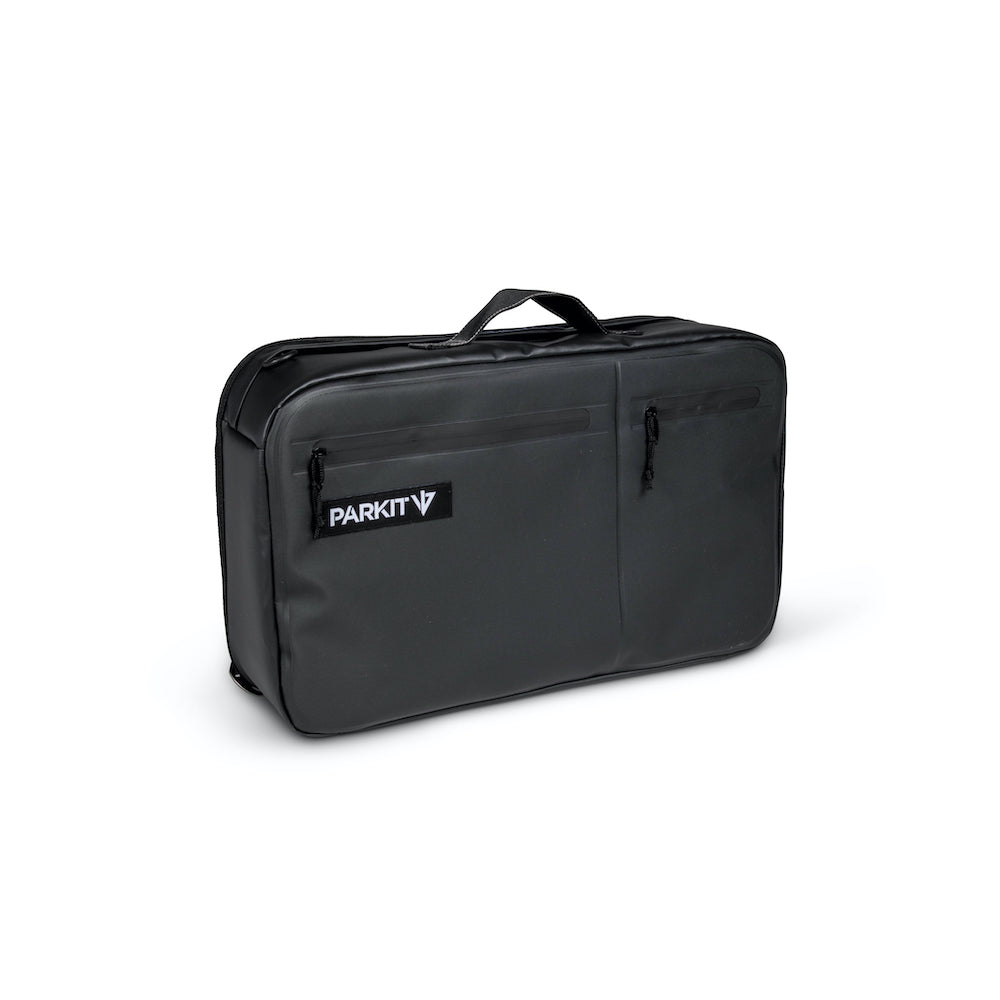
VOYAGER COOLER $69.99 USD
Welded, Insulated & Sealed, and detachable for use on it's own and compatible with our Voyager Carry Straps.

VOYAGER LTE $164.99 USD
A Cooler-less option, for those looking for a quality, light weight & easy to carry seat.
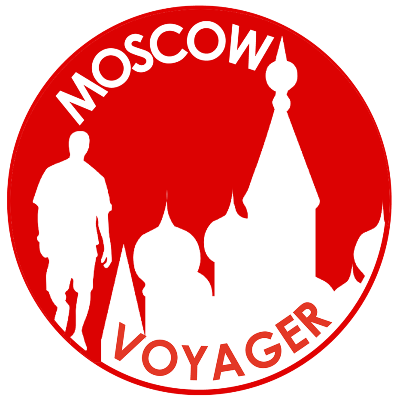
How do I get from Moscow airports to the city center?

Moscow with its more than twelve million inhabitants has three international airports. The best known is Sheremetyevo (international abbreviation SVO), which is 35 km northwest of Red Square. Russia’s largest airline Aeroflot has its hub here. The second largest airport, Domodedovo (international abbreviation DME), is about 45 km south-east of the center, from where the S7 airline, which mainly flies within Russia, and numerous international airlines such as Lufthansa take off and land. Finally, there is the third largest airport called Moscow-Wnukovo (abbreviation VKO), which serves numerous low-cost airlines such as Pobeda and is the closest to Moscow city center at just under 30 km.
Aeroexpress to the city center
First the good news – all three airports are easy to reach, both by taxi and by public transport such as train and bus. All three airports are connected to the Moscow city center by means of the so-called Aeroexpress. The Aeroexpress is certainly the most popular and the easiest way for foreigners to get to the center of Moscow. With the striking red signs Aeroexpress, you can find the way to the express trains both at Moscow’s three major airports and at the respective departure stations.
The modern, wifi-equipped trains from the private provider have little in common with the city railway trains from the Russian capital, which still originate from the Soviet era, and run to all three airports from early morning until after midnight. The schedule varies from airport to airport and time of day. As a rule of thumb, trains go to Sheremetyevo and Domodedovo every half an hour during the day to and from the airport, while Wnukowo is only served hourly for much of the day.
The same pricing scheme applies to all three airports: at 300 rubles (around $ 4.50) for a one-way trip, the prices for the trip are significantly more expensive than regular public transport tickets in Moscow, but are still affordable. Sheremetyevo and Vnukovo are each around 35 minutes from the center, and Domodedovo Airport is 45 minutes away.

If you buy the ticket in advance or via the app, there is a 50 ruble discount, further discounts are available if you book a return trip with one ticket, which costs 600 rubles (around $ 8.50). When it comes to value for money, the Aeroexpress trains are certainly the best option as a solo traveler. Especially since bypassing the often treacherous Moscow traffic – in the rush hour a drive by car can take an hour longer than previously estimated.
The biggest disadvantage is that you can of course not go directly to the desired destination within Moscow. However, all three Aeroexpress trains take you to one of the major Moscow train stations, which in turn are connected to the ring line of the Moscow Metro, from where you can quickly reach all corners of the center of Moscow.
Transport connections
- Sheremetyevo Airport -> Belorussky Vokzal (journey time 35 minutes)
- Domodedovo -> Paveletsky Vokzal (journey time 45 minutes)
- Wnukowo -> Kiewsky Vokzal (travel time 35 minutes)
Prices (apply to all three airports in the city and to the airport):
- One-way ticket at the counter = 300 rubles
- Online ticket = 300 rubles
- Round trip = 600 rubles
- Tickets for 10 trips = 2,300 rubles
- Ticket Business Class = 800 rubles
Link : timetables of the Aeroexpress trains to the city center
Link : timetables of the Aeroexpress trains to the airports
In the city or to the airport by taxi app
Alternatively, the transport from and to the airport can also be regulated using the taxi app. Yandex-Taxi and Gett are the two most popular providers in Moscow. At Yandex the flat rate to all three international airports currently costs 1100 rubles ($ 16) and at Gett even only 950 rubles ($ 14) in the cheapest variant, with a small car of the size VW Polo or Ford Focus.
Unless you want to go to the airport with too much luggage or with more than two people, this is certainly the easiest method. Moderate surcharges are required for larger vehicle categories. Without knowledge of Russian, however, it would be much easier to get to the airport by taxi app than from the airport to the city. Due to the confusing location in front of the three major airports, it may be necessary to contact the driver by phone to find the right vehicle. Because the GPS signal of the respective app only gives the location with an accuracy of about ten to fifteen meters – with several lanes running side by side in front of the terminal and dozens of waiting passengers and arriving taxis, it is certainly not always easy to find yourself straight away.
If you are still dependent on the WiFi of the airport building and therefore must not move too far from the entrance, the whole thing could prove to be difficult. From the city to the airport, however, the taxi app without knowledge of Russian proves to be the much easier method. The hotel or AirBnB address can be entered as the pick-up location, and a taxi can usually be ordered within a few minutes.
Moscow trip planned? Here you can find out how to get the necessary visa! !
With the classic taxi into the city
If you want to drive into the city by regular taxi, you have to expect considerable additional costs. The website of Domodedovo airport gives 2,000 rubles as a guide for a trip to the center, i.e. just $ 28. Trips to and from Vnukovo and Sheremetyevo should be a little cheaper. As with the taxi apps, the following also applies here: Especially at rush hour, you should probably prefer the train because Moscow’s streets burst at the seams in the after-hours traffic.
Bus metro combination
For experienced travelers to Russia or visitors with a particularly tight budget, there is still the option of all three airports to get to the nearest metro station by bus or Marshrutka (mini-bus with a fixed route but flexible stops).
From Vnukowo, for example, the 45M minibus line goes to the Yugo-Zapadnaya metro station on the red line № 1 of the Moscow Metro, for just 150 rubles. Together with the 62 rubles ticket for the metro, you can get into the city for just over $ 3.
Sheremetyevo Airport can be reached from the Rechnoy Vokzal metro station on Marshrutka line 949 for 80 rubles, or from Planernaya metro station with Marshrutka 948 for 80 rubles ($ 1.1). The minibuses run approximately every 15 minutes. Domodedovo Airport is connected by express bus to the metro station of the same name every half hour. The fare here is 150 rubles (a good 2,1 $). However, complications must be expected with this transport route – the bus drivers in Moscow usually only speak Russian. Taking the metro or minibuses with luggage is not always comfortable. However, you can save money, especially as a solo traveler.
Alexander Popov
Welcome to Russia! My name is Alexander, I was born in Moscow and I'm a passionate tour guide. I want to share my passion for Russia and my hometown with you. On my website you will find useful information to make your individual trip to Russia as interesting as possible.
The best taxi services in Moscow
Where to stay in moscow, you will also like, everything you need to know about russia: included..., traveling in russia – how safe it is..., choosing the best guide for a free and..., how do i exchange money in moscow, eating out in moscow, the best time to travel to russia, moscow’s best free city tour, moscow’s top 13 – the main attractions of..., with sim card purchase in russia: use whatsapp,..., leave a comment cancel reply.
Save my name, email, and website in this browser for the next time I comment.
@2019-2020 - Moscow Voyager. Alexander Popov
We use cookies to provide you with a better experience. By continuing to use our site you accept our cookie policy. Accept Read More

- The Contents
- The Making of
- Where Are They Now
- Frequently Asked Questions
- Q & A with Ed Stone
golden record
Where are they now.
- frequently asked questions
- Q&A with Ed Stone
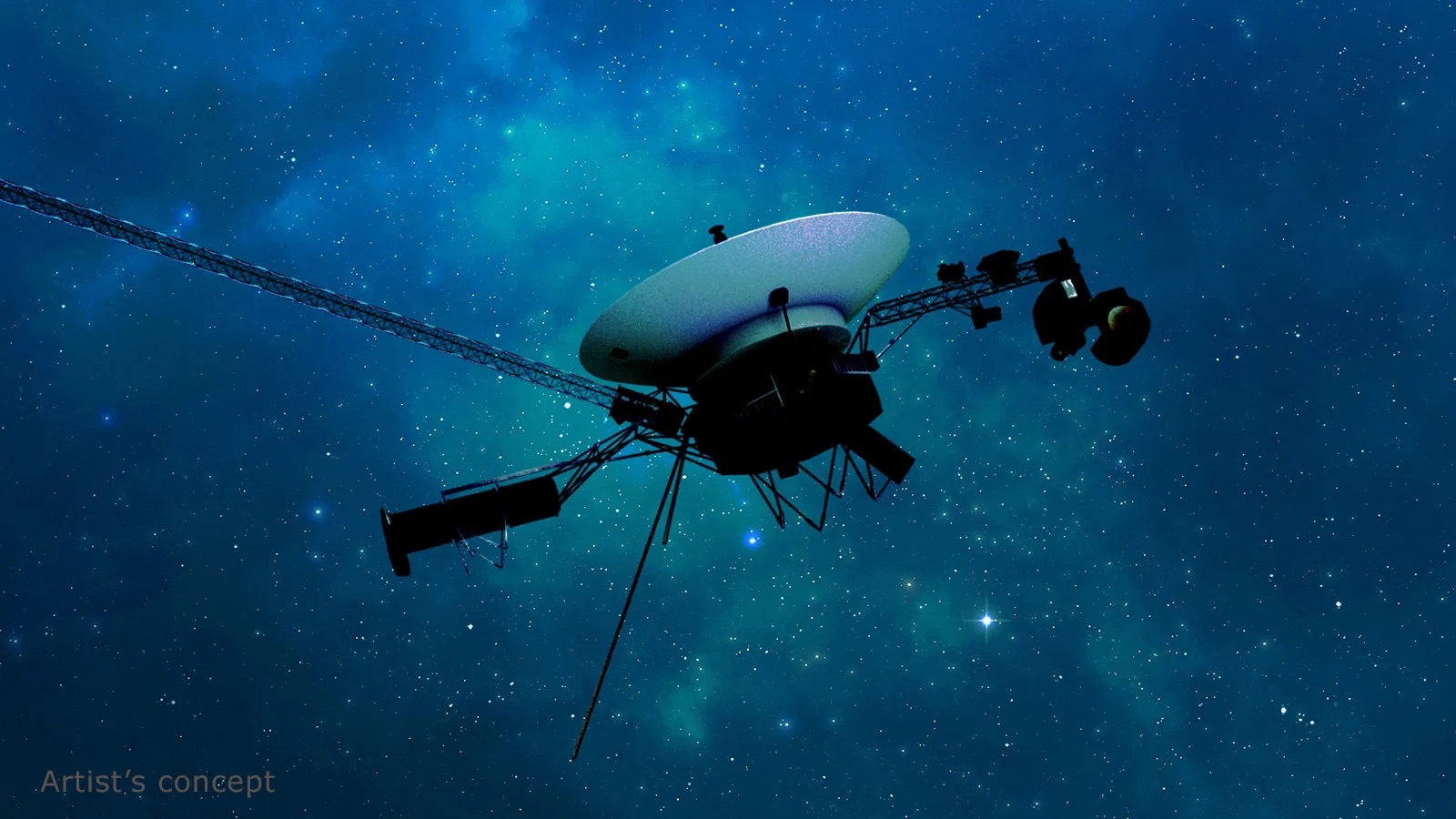
NASA’s Voyager Team Focuses on Software Patch, Thrusters

NASA Mission Update: Voyager 2 Communications Pause
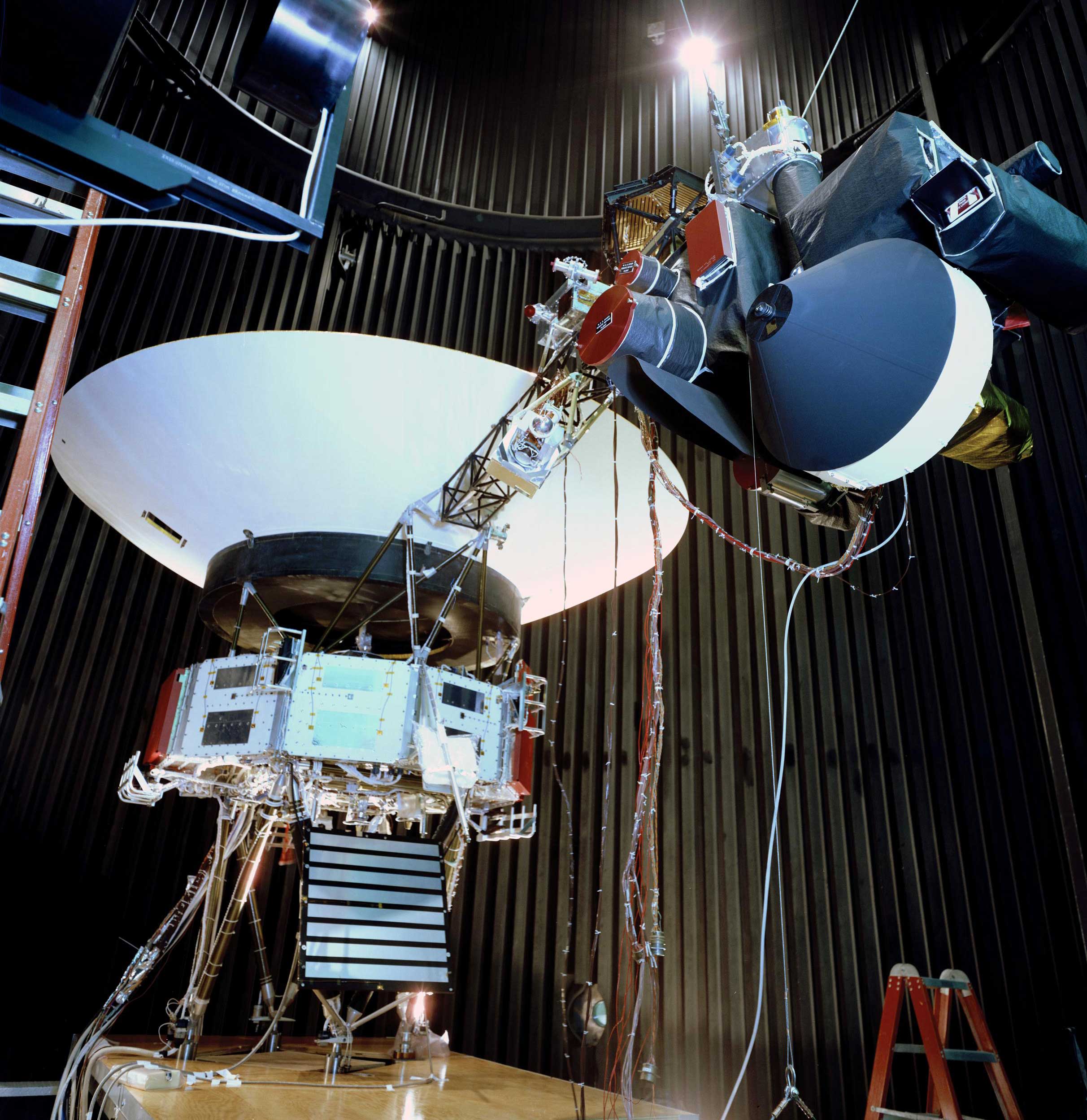
NASA's Voyager Will Do More Science With New Power Strategy
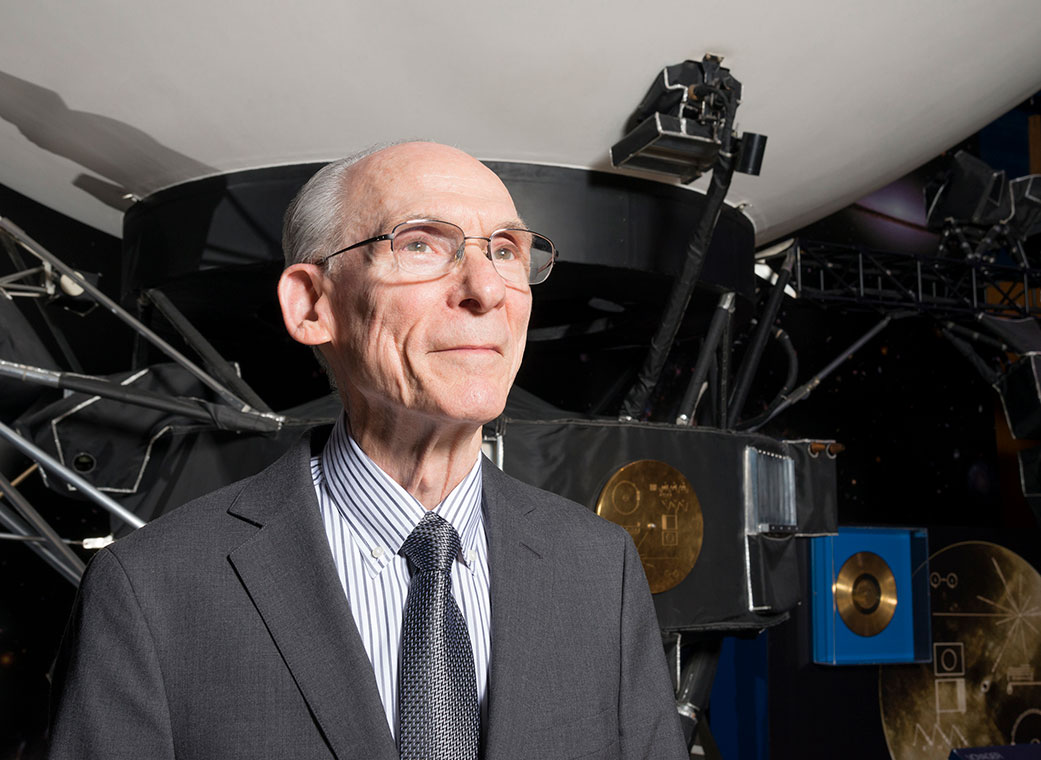
Edward Stone Retires After 50 Years as NASA Voyager's Project Scientist
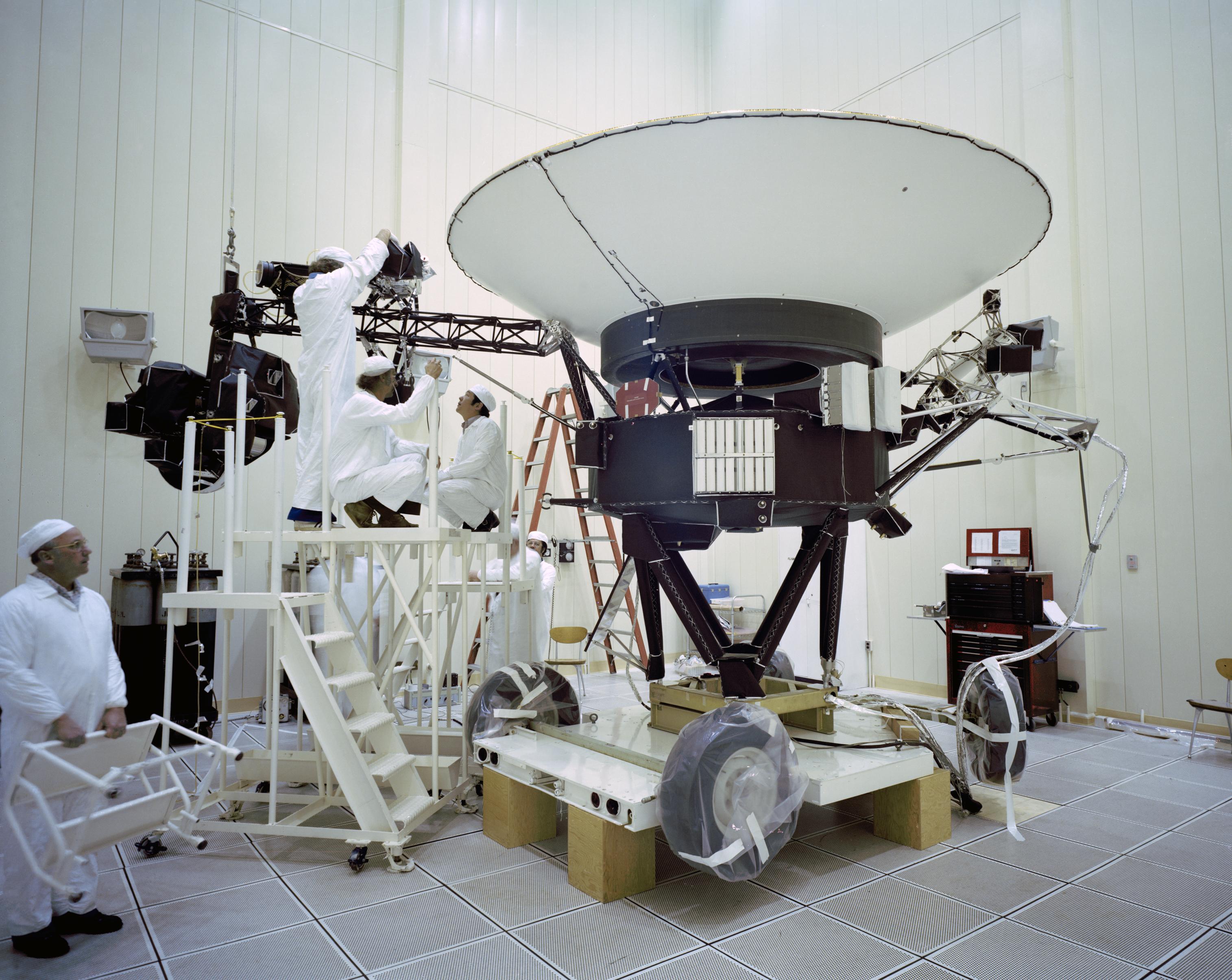
Voyager, NASA's Longest-Lived Mission, Logs 45 Years in Space
Voyager 1 distance from earth, voyager 1 distance from sun, voyager 1 one-way light time, voyager 1 cosmic ray data, voyager 2 distance from the earth, voyager 2 distance from the sun, voyager 2 one-way light time, voyager 2 cosmic ray data, what's happening now.
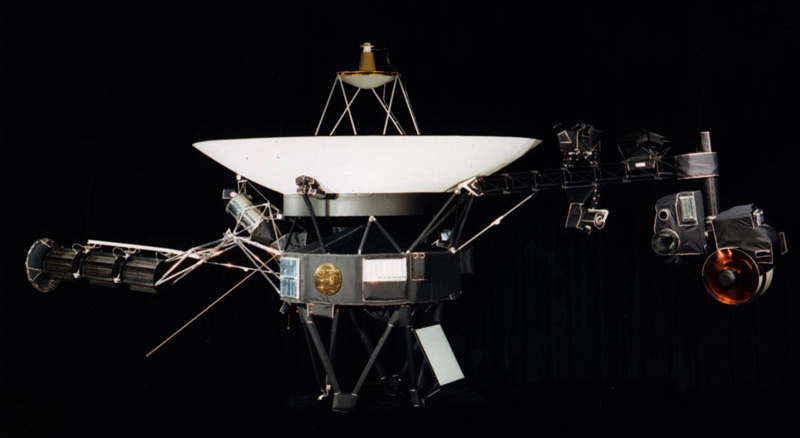
Since November 2023, NASA’s Voyager 1 spacecraft has been sending a steady radio signal to Earth, but the signal does not contain usable data.
Engineers are working to resolve an issue with one of Voyager 1’s three onboard computers, called the flight data system (FDS).
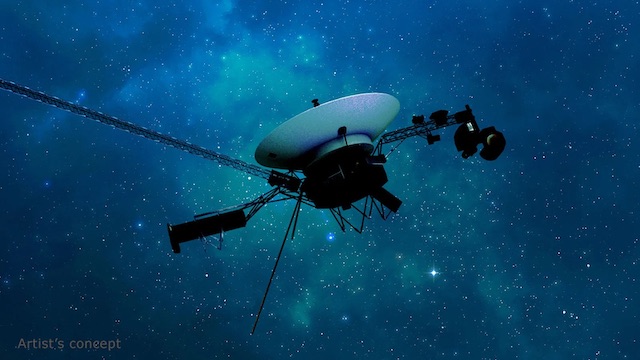
The efforts should help extend the lifetimes of the agency's interstellar explorers.

Download the Voyager 40th Anniversary posters.
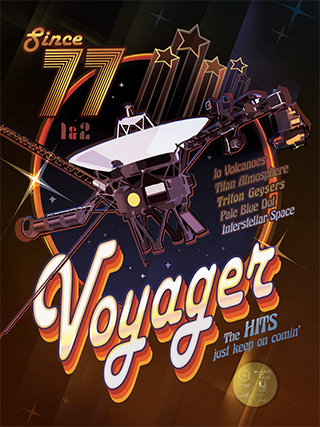

IMAGES
VIDEO
COMMENTS
Paradigit Voyager wordt slechts eenmalig uitgebracht. Om de exclusiviteit te waarborgen, is de oplage ook beperkt tot slechts 5 stuks. Geïnteresseerden dienen dus tijdig een bestelling te plaatsen bij Paradigit om in aanmerking te kunnen komen voor deze zeer exclusieve gaming pc. Windows 10: het beste van oud en nieuw in één
Voyager 1 Present Position. This simulated view of the solar system allows you to explore the planets, moons, asteroids, comets, and spacecraft exploring our solar system. You can also fast-forward and rewind in real-time. NASA/JPL-Caltech.
Paradigit has its own line of desktop computers under the 'Built by Paradigit' label; Paradigit was formerly known as komplett; Paradigit due to its 25th anniversary in 2017 built the 'best gaming PC' ever. The Paradigit Voyager worth €13,999. Paradigit was voted 'Best Computer Store in the Netherlands' no less than 10 times in a row.
A poster of the planets and moons visited during the Voyager program. The Voyager program is an American scientific program that employs two interstellar probes, Voyager 1 and Voyager 2.They were launched in 1977 to take advantage of a favorable alignment of the two gas giants Jupiter and Saturn and the ice giants, Uranus and Neptune, to fly near them while collecting data for transmission ...
The Voyager CCS and Viking CCS would ultimately have the same amount of memory (just under 70kB) despite the routines and programs for Voyager being much more complex. In-flight programming allowed for new routines and programs to be uploaded regularly in non-volatile memory and eliminated the need for large amounts of memory to be required ...
The Voyager program was setup initially to study several of the outer planets by taking advantage of an alignment between Jupiter, Saturn, Uranus, and Neptune. However, the two probes are still functioning and sending back valuable scientific data more than 40 years after their launch. In this article, we will look at the power source for the ...
In 1977, Voyager 1 and 2 started their one-way journey across our galaxy, travelling a million miles a day. Jonathan Margolis meets the dedicated team keeping the craft moving. O n a chilly March ...
818-354-5011. 1991-1400. More than two years after Voyager 2 looked Neptune's Great Dark Spot in the eye and darted past the frozen surface of its moon Triton, both Voyager spacecraft are continuing to return data about interplanetary space and some of our stellar neighbors near the edges of the Milky Way.
The Voyager Interstellar Mission has the potential for obtaining useful interplanetary, and possibly interstellar, fields, particles, and waves science data until around the year 2025 when the spacecraft's ability to generate adequate electrical power for continued science instrument operation will come to an end. › Find out more Fast Facts
Voyager 2 was the first to launch, with Voyager 1 following two weeks later. Both carried the famous " Golden Record ," a 12-inch gold-plated copper disc containing sounds and images portraying ...
Voyager 2 is also escaping the solar system at a speed of about 3.1 AU per year, 48 degrees out of the ecliptic plane to the south toward the constellations of Sagitarrius and Pavo. In about 40,000 years, Voyager 2 will come within about 1.7 light years of a star called Ross 248, a small star in the constellation of Andromeda. ...
Voyager 2 entered interstellar space on November 5, 2018 and scientists hope to learn more about this region. Both spacecraft are still sending scientific information about their surroundings through the Deep Space Network, or DSN. The primary mission was the exploration of Jupiter and Saturn. After making a string of discoveries there — such ...
Voyager 1 has been exploring our solar system for more than 45 years. The probe is now in interstellar space, the region outside the heliopause, or the bubble of energetic particles and magnetic fields from the Sun. Voyager 1 is the first human-made object to venture into interstellar space. Voyager 1 discovered a thin ring around Jupiter and ...
Scribd is the world's largest social reading and publishing site.
Centrino 1.7Ghz, 1GB RAM, Paradigit Voyager "Rock solid", titanium, black magnesium shielding, military style, 3.5kg,15.4 inch SXGA+ (1400 x 1050), Paradigit Rocksolid 9160
Note: Because Earth moves around the sun faster than Voyager 1 is speeding away from the inner solar system, the distance between Earth and the spacecraft actually decreases at certain times of year. Distance from Sun: This is a real-time indicator of Voyagers' straight-line distance from the sun in astronomical units (AU) and either miles (mi ...
Walking tour around Moscow-City.Thanks for watching!MY GEAR THAT I USEMinimalist Handheld SetupiPhone 11 128GB https://amzn.to/3zfqbboMic for Street https://...
VOYAGER boast a lightweight, rust-free aerospace grade aluminum frame with a 350lb weight capacity. The arm rest are sourced from the same wood-like material as modern day boat docks and outdoor patios. Lastly, all engineered movement occurs inside casted joints that protect important mechanical elements ensuring years of use.
Free Tours Moscow - Daily. Practical information: «First acquaintance with Moscow» - a 2.5-hour city tour in the center of Moscow. Practical information: A 3.5-hour car/bus tour of Moscow. Practical information: Metro tour - daily. Practical information: Tour of Communist Moscow - every day.
NEPTUNE When Voyager flew within 5,000 kilometers (3,000 miles) of Neptune on August 25, 1989, the planet was the most distant member of the solar system from the Sun. (Pluto once again will become most distant in 1999.) Neptune orbits the Sun every 165 years. It is the smallest of our solar system's gas giants.
With the classic taxi into the city. Bus metro combination. First the good news - all three airports are easy to reach, both by taxi and by public transport such as train and bus. All three airports are connected to the Moscow city center by means of the so-called Aeroexpress. The Aeroexpress is certainly the most popular and the easiest way ...
This is a real-time indicator of Voyager 1's distance from Earth in astronomical units (AU) and either miles (mi) or kilometers (km). Note: Because Earth moves around the sun faster than Voyager 1 is speeding away from the inner solar system, the distance between Earth and the spacecraft actually decreases at certain times of year.
There are lots to see in the city centre of Moscow, so we decided to start our series of Russia travel videos by showing you around the most historical part ...